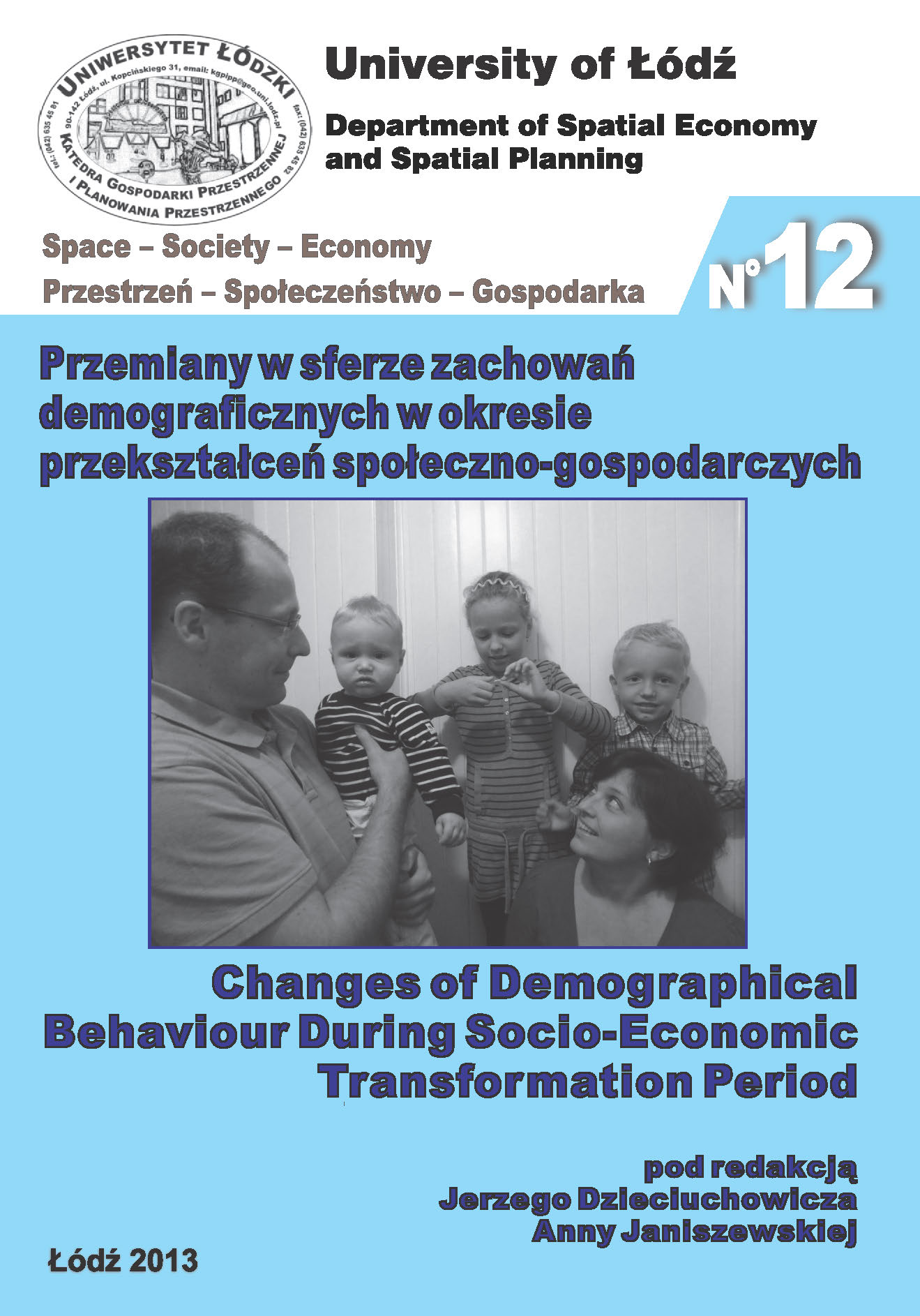Wzorzec płodności a wzorzec małżeńskości w Polsce po okresie transformacji
DOI:
https://doi.org/10.18778/1733-3180.12.10Abstrakt
Observed since the beginning of the 1990s. changes in the intensity of marriages and fertility are the result of different of their raters by age. At the same time, these processes are different in urban and rural areas and by voivodeships. The purpose of the article is their description and shows how degree of the pattern of fertility determines the degree of pattern of marriages by voivodeships. We expect that the stronger changes of one of the process also means stronger the second changes. Carried out considerations have not confirmed this assumption.
Pobrania
Bibliografia
Adsera A., 2004, Changing fertility rates in developed countries. The impact of labour market institutions, “Journal of Population Economics”, vol. 17, 1‒27.
Google Scholar
DOI: https://doi.org/10.1007/s00148-003-0166-x
Becker G.S., 1960, Demographic and economic change in developed countries [w:] An economic analysis of fertility, National Bureau of Economic Research (ed.), NJ: Princeton University Press, Princeton, 209‒231.
Google Scholar
Becker G.S., 1976, The economic approach to human behavior, Chicago University Press, Chicago.
Google Scholar
DOI: https://doi.org/10.7208/chicago/9780226217062.001.0001
Becker G.S., 1981, A treatise on the family, Harvard University Press, Cambridge, Mass.
Google Scholar
Budnik A., Mrowicka B., Baran S., 2007, The fertility of women in Poland in the period of transformation of the political and economics system (the 80’s and 90’s), “Human Evolution”, vol. 18, no 3‒4, s. 243‒250.
Google Scholar
DOI: https://doi.org/10.1007/BF02436290
Chojnicki Z., 1996, Region w ujęciu geograficzno-systemowym [w:] Czyż T. (red.), Podstawy regionalizacji geograficznej, nr 3, Bogucki Wydawnictwo Naukowe, Poznań, s. 7‒43.
Google Scholar
Czyż T., 2002, Zastosowanie modelu potencjału w analizie zróżnicowania regionalnego Polski, „Studia Regionalne i Lokalne”, nr 2‒3, s. 5‒14.
Google Scholar
Easterlin R.A., 1966, On the relation of economic factors to recent and projected fertility changes, “Demography”, no 3, s. 131‒153.
Google Scholar
DOI: https://doi.org/10.2307/2060068
Easterlin R.A., 1968, Relative economic status and the American fertility swing [w:] Sheldon E.B. (ed.), Family economic behavior: problems and prospects, Philadelphia: Lippincott, s. 170‒233.
Google Scholar
Easterlin R.A., 1975, An economic framework for fertility analysis, “Studies in Family Planning”, no 6, s. 54‒62.
Google Scholar
DOI: https://doi.org/10.2307/1964934
Florczak W., 2008, Makroekonomiczne uwarunkowania płodności w Polsce: próba kwantyfikacji, „Studia Demograficzne”, nr 1‒2/153‒154, s. 82‒111.
Google Scholar
Frątczak E., 2000, Changes in Fertility Pattern in Poland during the Transformation Period ‒ Measurement and Interpretation, “Polish Population Review”, nr 16, s. 16‒32.
Google Scholar
Gołata E., 1995, Płodność i małżeńskość w Polsce w okresie transformacji społeczno-gospodarczej, „Studia Demograficzne”, nr 3/121, s. 14‒24.
Google Scholar
Kocot-Górecka K., 2002, Aktywność ekonomiczna kobiet a zmiany wzorca płodności w Polsce, praca doktorska, ISiD, KAE, SGH, Warszawa.
Google Scholar
Kotowska I.E., 2007, Zmiany modelu rodziny. Polska – kraje europejskie, „Polityka Społeczna”, nr 4, s. 5‒7.
Google Scholar
Kotowska I.E., Jóźwiak J., Matysiak A., Baranowska A., 2008, Poland: Fertility decline as a response to profund societal and labour market changes?, “Demographic Research”, vol. 19, s. 795‒854.
Google Scholar
DOI: https://doi.org/10.4054/DemRes.2008.19.22
Leibenstein H., 1974, Relation of economic development to fertility [w:] Tabah L. (ed.), “Population Growth and Economic Development in the Third World”, vol. 2, s. 473‒490.
Google Scholar
Leibenstein H., 1975a, The economics theory of fertility decline, “Quarterly Journal of Economics”, no 84, s. 1‒13.
Google Scholar
DOI: https://doi.org/10.2307/1881706
Leibenstein H., 1975b, On the economic theory of fertility behavior: a reply to Keeley, “Journal of Ecomomic Literature”, no 13, s. 469‒472.
Google Scholar
Matysiak A., 2005, The sharing of professional and household duties between Polish couples: preferences and actual choices, “Studia Demograficzne”, nr 1, s. 122‒154.
Google Scholar
Mishtal J.Z., 2010, Understanding low fertility in Poland. Demographic consequences of gendered discrimination in employment and post-socialist neoliberal restructuring, “Demographic Research”, vol. 21, s. 599‒626.
Google Scholar
DOI: https://doi.org/10.4054/DemRes.2009.21.20
Podogrodzka M., 2011, Zachowania prokreacyjne ludności na obszarach miejskich i wiejskich w Polsce w latach 1990‒2009, „Wieś i Rolnictwo”, nr 2, s. 146‒163.
Google Scholar
Podogrodzka M., 2012a, Bezrobocie determinantą przestrzennego zróżnicowania płodności według miejsca zamieszkania w Polsce w latach 1999‒2009, „Wieś i Rolnictwo”, nr 1, s. 119‒131.
Google Scholar
Podogrodzka M., 2012b, Zmiany zachowań matrymonialnych na obszarach miejskich i wiejskich w Polsce w latach 1990‒2009, „Wieś i Rolnictwo”, nr 3, s. 78‒96.
Google Scholar
Reid M, 1977, How now is the „New Home Economics”?, “Journal of Consume Research”, no 4, s. 181‒191.
Google Scholar
DOI: https://doi.org/10.1086/208696
Toński P., 1999, Przestrzenne zróżnicowanie płodności w Polsce w latach 1989‒1997, „Studia Demograficzne”, nr 1/135, s. 18‒35.
Google Scholar
Westoff C.F., 1975, The Yield of the impertect: the 1970 National Fertility Study, “Demography”, no 12, s. 573‒580.
Google Scholar
DOI: https://doi.org/10.2307/2060714
Westoff C.H.F., Calot G., Foster A.D., 1983, Teenage Fertility in Developed Nations 1971‒1980, “Family Planning Perspectives”, no 15, s. 3‒24.
Google Scholar
DOI: https://doi.org/10.2307/2134728
Pobrania
Opublikowane
Jak cytować
Numer
Dział
Licencja

Utwór dostępny jest na licencji Creative Commons Uznanie autorstwa – Użycie niekomercyjne – Bez utworów zależnych 4.0 Międzynarodowe.









